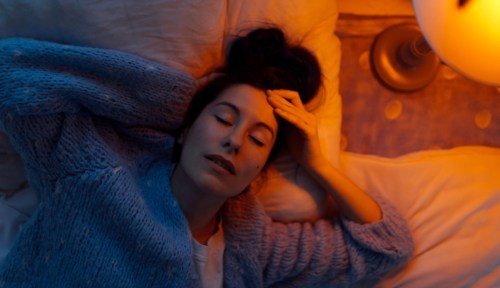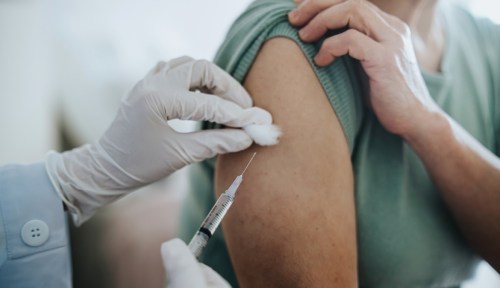Our editors independently select these products. Making a purchase through our links may earn Well+Good a commission
How Hormone Changes During Your Menstrual Cycle and Throughout Life Can Affect Your Risk of Migraine Attacks
Learn why fluctuations in female reproductive hormones during the menstrual cycle and throughout life can cause or worsen migraines.

Hormones are often portrayed in a lighthearted (if occasionally derogatory) manner. They’re positioned as the reason the pregnant lady cries, the teenager recoils in angst, and the premenstrual woman eats ice cream straight from the gallon. Effects on mood aside, however, hormones are essential for life. Among many things, they are also the reason a pregnancy can be sustained, why kids grow, and how our bodies balance the electrolytes necessary for survival. And in some women and other people with female anatomy or physiology, hormones also have a more sinister side: They can cause or contribute to debilitating migraines.
Experts in This Article
senior general practitioner headache specialist the National Migraine Centre, host of the National Migraine Centre’s Heads Up podcast, and author of Managing Your Migraine
family physician and national program medical director of sexual and reproductive health at primary care provider One Medical
neurologist and associate professor of neurology at Mayo Clinic with a special interest in understanding the gender differences in migraine
In childhood, people of both sexes are at equal risk for migraine attacks, but after puberty, women are two to three times more likely1 to experience them. And according to the American Migraine Foundation, women are three times more likely than men to live with migraines, with their first attack often occurring around the time they get their first period.
A female person’s hormonal state will not only fluctuate in monthly cycles, but also throughout their lifetime, with changes like pregnancy, postpartum, perimenopause, and menopause. And with all of these changes, migraines (and the risk for having an attack) can change, too.
“Migraine is a genetic condition, but whether you actually get the attacks also depends on a number of different epigenetic factors…and one of those is estrogen.” —Katy Munro, MBBS, headache specialist at the National Migraine Centre
To be sure, migraine is a largely genetic condition, says general practitioner Katy Munro, MBBS, a senior GP headache specialist at the National Migraine Centre, in the United Kingdom, and author of Managing Your Migraine. (Technically, migraine is the condition, and a migraine attack is the result of the condition.) “Certain genes give your brain a vulnerability to have migraine attacks,” she says. “But whether you actually get the attacks also depends on a number of different epigenetic factors, or factors within and outside your body [including lifestyle and environmental variables], and one of those really powerful factors is [the female sex hormone] estrogen.”
Dr. Munro clarifies that while the common perception of migraine is that it’s just a “bad headache,” it can encompass a lot more than that. Some people with migraine don’t actually have a debilitatingly painful headache; they might have other non-headache symptoms2 like brain fog, nausea, or neck and shoulder pain (or, more likely, some combination of these symptoms).
In general, people with migraine have a brain that is more sensitive to change, says Dr. Munro. Things like too much or too little sleep, or a spike in blood glucose levels3 can contribute to the development of a migraine attack. It isn’t often just one thing that will trigger a migraine, she adds; it’s a combination of triggers stacking on top of one another that begins the roll of an attack, and among them are various, often inescapable changes in female reproductive hormones.
How hormones can cause or contribute to migraines
One theory posits that the fluctuating hormones of the menstrual cycle might just irritate or set off the naturally sensitive migraine brain, putting women at higher risk of a migraine attack.
It’s also possible that in some people with migraine, quicker or more precipitous drops in estrogen4 at the end of their menstrual cycle may make the brain more sensitive to prostaglandins, or hormone-like chemicals tied to pain and inflammation, says Dr. Munro.
Some research has shown that transgender women on estrogen therapy are more likely to have migraines than cisgender men5, and conversely, that transgender men on testosterone therapy have fewer migraines than cisgender women—all of which highlights the role of changing levels of estrogen when it comes to the risk of a migraine attack.
During menstruation
Estrogen and progesterone fluctuate throughout the menstrual cycle, with both hormones typically plummeting at the very end of the cycle, prior to the start of menstrual bleeding (and of the next cycle). “What the studies seem to indicate is that it’s falling levels of estrogen at the end of the menstrual cycle6 that are particularly powerful in aggravating the vascular pathway that triggers migraine attacks,” says Dr. Munro.
“Falling levels of estrogen at the end of the menstrual cycle are particularly powerful in aggravating the vascular pathway that triggers migraine attacks.” —Dr. Munro
Indeed, of the women who experience migraines, about 60 to 70 percent notice a connection between their migraines and menstruation, seeing an uptick in their migraines on the days leading up to their period and/or during the first three days of their period, when estrogen and progesterone are at their lowest.
Research shows that about 2.7 percent of people have pure menstrual migraines7 (PMM), meaning they only have migraines around the time of their period, whereas 4.6 percent have menstrually related migraines (MRM), meaning they get migraines more frequently around their period but also have them at other times in the month. “We don’t fully understand why some women get pure menstrually related attacks and others have attacks both around menstruation and at other times in the month,” says Dr. Munro. “It is part of the complexity of migraine that makes it a challenge for the individual to search for their own solution.”
Hormonal contraception
Because the migraine brain is, again, sensitive to change, fluctuating estrogen levels can be a trigger for more migraine attacks, whereas stable estrogen levels may reduce the number of attacks. As a result, hormonal birth control may either increase or decrease the frequency of migraine attacks, largely depending on whether it’s causing more or less hormonal change than the person’s baseline, says family physician Navya Mysore, MD, who is a chronic migraineur herself and the national program medical director of sexual and reproductive health at One Medical. “It really depends on the patient and their response to the birth control.”
Dr. Mysore adds one important note: Combined hormonal birth control—which contains both estrogen and progesterone—is contraindicated for people who get migraine with aura (or temporary visual or other sensory disturbances that occur before a migraine attack strikes) as it can increase the risk of stroke. (Note that all hormonal IUDs are progesterone-only, meaning they are considered safe for people who experience auras8.)
For people who get migraines without aura, however, “it may be worth trying a hormonal birth control method [containing estrogen] to see if it might help, especially if you notice that your episodes are around ovulation or right before getting your period,” says Dr. Mysore.
Pregnancy
“Pregnancy is a time where hormones are typically stable and not fluctuating,” says neurologist Rashmi Halker Singh, MD. It is common for migraine attacks to continue during the first trimester of pregnancy, “because hormone levels are continuing to change and build,” she says. But in the second and third trimesters, the majority of people with migraine will notice a decrease in their migraine attacks9.
That said, there is one subset of people with migraine who may not experience this pregnancy-related dip: those who get auras, who are actually more likely to be triggered when in a high estrogen state like that of pregnancy, says Dr. Halker Singh. (For the same reason, some people who have never had an aura with their migraine attacks can also start experiencing migraine with aura while they are pregnant10.)
Postpartum
In a study that followed women with a history of migraines during and after pregnancy, 55 percent noticed a return of their migraines within the first month postpartum. The huge drop in estrogen and progesterone post-birth is likely responsible for that resurgence of migraine attacks, says Dr. Mysore. As a result of this major hormonal swing, women who have never experienced a migraine before may also start experiencing them in the postpartum period.
It’s not just the hormones that increase the risk for migraine attacks during the postpartum period, though: That cute baby is also responsible for the sleep deprivation, the stress, and the fact that dinner might be a Reese’s Peanut Butter Cup washed down by the cold coffee you never got a chance to drink during the day. Such behavioral and lifestyle changes—like missing out on sleep and skipping meals—fall into the bucket of common migraine triggers themselves.
While it’s true that breastfeeding may have a protective effect against migraine attacks11 (due to the ways in which lactation keeps estrogen levels steady and delays the return of menstruation), the exhaustion and stress that can come along with it may negate those benefits12.
Perimenopause
Perimenopause is the time during which the body transitions to menopause, and levels of reproductive hormones (like estrogen) begin to drop. It generally begins when a person is in their forties but can start earlier or later. The associated decrease in estrogen levels—which often occurs erratically throughout the transition—can certainly result in an uptick in migraine attacks, says Dr. Halker Singh.
But Dr. Munro points out that just as in postpartum, it’s not solely the hormones that can cause migraines to surge during this phase of life; it can also be the related lifestyle and behavioral changes. In the case of perimenopause, you might be dealing with difficulty sleeping or the stress of big life changes (perhaps a job promotion), the loss of an elderly parent, or parenting a teenager.
But don’t lose all hope: In many cases, migraine attacks do decrease in menopause (more on that below). Then again, the median length of perimenopause is four years13; and for some unlucky souls, it can last longer than 10 years.
Menopause
Menopause is technically defined as the point in time 12 months after a person’s last menstrual period, when their reproductive capacity has ended. After the erratic fluctuations of perimenopause, hormones tend to level out in menopause, and for many, migraine attacks decrease as a result. Even for those in whom migraines don’t disappear completely, Dr. Munro notes that “they may be easier to treat or less troublesome [during menopause.]”
While you may seek hormone replacement therapy (HRT) with the approval of a doctor to treat menopause symptoms that can contribute to migraines—like hot flashes, night sweats, insomnia, and many others—the use of HRT can also cause more migraine attacks by triggering hormone fluctuations, says Dr. Munro, so it’s important to work with a specialist to find the right medication for you.
Are other hormones responsible for triggering migraines?
Estrogen holds a lot of power when it comes to triggering migraine attacks, but it is not the only hormone that can wreak havoc. Consider how adrenaline and cortisol can spike during stressful situations, says Dr. Munro, and how stress can contribute to migraine attacks.
But while some people experience migraine attacks while they are stressed out, others notice that they get the attack after the stressful situation resolves, says Dr. Munro, leading her to conclude that it’s less about the particular hormone in play, and more about fluctuation: “When anything in your body is a bit off-kilter, then you’re more likely to have the vulnerability of having migraine attacks.”
In general, “migraine changes throughout life because everything changes throughout life,” says Dr. Munro. “Migraine is the way that the brain processes change, and so with our body and our environment and our life stressors changing, the brain reacts to that.”
Vetvik, Kjersti Grøtta, and E Anne MacGregor. “Sex differences in the epidemiology, clinical features, and pathophysiology of migraine.” The Lancet. Neurology vol. 16,1 (2017): 76-87. doi:10.1016/S1474-4422(16)30293-9
↩︎Chen, Ping-Kun, and Shuu-Jiun Wang. “Non-headache symptoms in migraine patients.” F1000Research vol. 7 188. 14 Feb. 2018, doi:10.12688/f1000research.12447.1
↩︎Islam, Md Rafiqul, and Dale R Nyholt. “Glucose-Related Traits and Risk of Migraine-A Potential Mechanism and Treatment Consideration.” Genes vol. 13,5 730. 22 Apr. 2022, doi:10.3390/genes13050730
↩︎Pavlović, Jelena M et al. “Sex hormones in women with and without migraine: Evidence of migraine-specific hormone profiles.” Neurology vol. 87,1 (2016): 49-56. doi:10.1212/WNL.0000000000002798
↩︎Ahmad, Sarah R, and Nicole Rosendale. “Sex and Gender Considerations in Episodic Migraine.” Current pain and headache reports vol. 26,7 (2022): 505-516. doi:10.1007/s11916-022-01052-8
↩︎- Raffaelli, Bianca et al. “Menstrual migraine is caused by estrogen withdrawal: revisiting the evidence.” The journal of headache and pain vol. 24,1 131. 21 Sep. 2023, doi:10.1186/s10194-023-01664-4↩︎
Vetvik, Kjersti Grøtta et al. “Self-reported menstrual migraine in the general population.” The journal of headache and pain vol. 11,2 (2010): 87-92. doi:10.1007/s10194-010-0197-0
↩︎- Edlow, Andrea G, and Deborah Bartz. “Hormonal contraceptive options for women with headache: a review of the evidence.” Reviews in obstetrics & gynecology vol. 3,2 (2010): 55-65.↩︎
Goadsby, Peter J et al. “Migraine in pregnancy.” BMJ (Clinical research ed.) vol. 336,7659 (2008): 1502-4. doi:10.1136/bmj.39559.675891.AD
↩︎Paškevičiūtė, Elena et al. “De novo Migraine with Aura in the Third Trimester of Pregnancy: A Case Report and Literature review.” Acta medica Lituanica vol. 28,1 (2021): 145-152. doi:10.15388/Amed.2021.28.1.19
↩︎Sances, G et al. “Course of migraine during pregnancy and postpartum: a prospective study.” Cephalalgia : an international journal of headache vol. 23,3 (2003): 197-205. doi:10.1046/j.1468-2982.2003.00480.x
↩︎Turankar, Tileshkumar et al. “Relation and Treatment Approach of Migraine in Pregnancy and Breastfeeding.” Cureus vol. 15,3 e36828. 28 Mar. 2023, doi:10.7759/cureus.36828
↩︎Hutchinson, Susan et al. “Use of common migraine treatments in breast-feeding women: a summary of recommendations.” Headache vol. 53,4 (2013): 614-27. doi:10.1111/head.12064
↩︎Delamater, Lara, and Nanette Santoro. “Management of the Perimenopause.” Clinical obstetrics and gynecology vol. 61,3 (2018): 419-432. doi:10.1097/GRF.0000000000000389
↩︎
Sign Up for Our Daily Newsletter
Get all the latest in wellness, trends, food, fitness, beauty, and more delivered right to your inbox.
Got it, you've been added to our email list.










